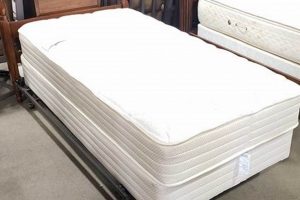The removal and discarding of bed frames and sleeping surfaces that are no longer usable represents a significant waste management challenge. This process often involves bulky items requiring specialized handling due to their size and composition. Improper handling can lead to environmental concerns and contribute to landfill overcrowding.
Responsible management of these items is essential for promoting sustainability and reducing environmental impact. Historically, these items were often simply left for collection as part of general waste. However, increasing awareness of environmental issues and the potential for recycling components have led to the development of more sophisticated approaches to handling these materials.
The subsequent sections will delve into available methods for managing these items, including donation options, recycling processes, and proper disposal protocols. This information aims to provide a comprehensive overview of environmentally sound and legally compliant approaches.
Box Spring and Mattress Disposal
Properly managing the end-of-life stage of sleep products is critical for both environmental responsibility and adherence to local regulations. These guidelines offer practical advice for navigating the removal and discarding process.
Tip 1: Research Local Regulations: Municipalities often have specific guidelines regarding the disposal of large items. Contact the local waste management authority or consult the city’s website for details on permitted disposal methods and any associated fees.
Tip 2: Explore Donation Options: If the items are in usable condition, consider donating them to local charities or organizations that accept furniture donations. Ensure that the items meet the organization’s standards for cleanliness and structural integrity.
Tip 3: Investigate Recycling Programs: Many areas offer specialized recycling programs for mattresses and box springs. These programs disassemble the items and recycle components such as steel springs, foam, and wood. Search for recycling facilities in the area or contact waste management services for information.
Tip 4: Consider Professional Removal Services: If donation or recycling is not feasible, engage a professional junk removal service. These companies are equipped to handle the removal and disposal of bulky items responsibly, often ensuring that reusable materials are recycled where possible.
Tip 5: Prepare Items for Removal: Before disposal, take steps to protect the environment and waste management personnel. Wrap the mattress and box spring in plastic to prevent the spread of bed bugs or other contaminants. This also safeguards the items from moisture during transportation.
Tip 6: Verify Disposal Methods: If using a waste removal service, confirm their disposal practices. Ensure that they are committed to responsible waste management and that items will be processed in compliance with environmental regulations.
Adhering to these guidelines ensures responsible handling, mitigating environmental impact and promoting resource recovery. Choosing the correct disposal method also avoids potential fines for improper waste disposal.
The next section will address common challenges associated with this process and explore innovative solutions for managing this waste stream.
1. Regulations Compliance
Adherence to regulations is a paramount concern in the context of mattress and box spring removal. Non-compliance can lead to financial penalties, legal repercussions, and damage to an organization’s reputation. Many municipalities have established specific protocols for handling these bulky waste items, often prohibiting their inclusion in standard curbside collection due to their size and potential environmental impact. Some jurisdictions mandate recycling or require special handling to prevent the spread of pests, such as bed bugs. Failure to follow these regulations can result in fines and mandated remediation efforts.
The specific requirements vary significantly across different geographic locations. For example, certain states have implemented “mattress stewardship” programs, funded by a small fee collected on each new mattress sale. These programs facilitate recycling efforts and provide funding for proper disposal infrastructure. In contrast, other regions may lack such comprehensive programs, relying instead on local ordinances governing waste management practices. A business or individual must conduct thorough research to determine the precise regulations applicable within their jurisdiction.
Ultimately, regulatory compliance is not merely a matter of avoiding penalties but a demonstration of environmental responsibility. By understanding and adhering to applicable regulations, stakeholders contribute to the reduction of landfill waste, the conservation of resources, and the protection of public health. Challenges remain in the variability of regulations and the need for ongoing education to ensure widespread compliance, but the benefits of responsible disposal are undeniable.
2. Donation viability
The feasibility of donating used mattresses and box springs significantly impacts waste management strategies. Donation provides an environmentally and socially responsible alternative to landfill disposal. When donation is viable, it reduces the volume of waste requiring processing and lessens the demand for raw materials needed to manufacture new products. The condition of the items is a critical factor; mattresses and box springs must meet certain hygiene and safety standards to be considered acceptable for donation. Organizations accepting these items typically have strict guidelines regarding stains, tears, and infestations to protect recipients’ health and well-being. Failure to meet these standards renders donation infeasible, necessitating alternative disposal methods.
The presence of bed bugs, for example, invariably eliminates donation as an option. Similarly, significant structural damage, such as broken springs or sagging support, disqualifies items. Organizations that accept donations often lack the resources to repair or sanitize damaged goods, making adherence to condition guidelines essential. A real-world example is Goodwill Industries; while they accept furniture donations, they maintain stringent criteria for mattresses and box springs. Items are carefully inspected, and those that do not meet their standards are rejected. The practical significance lies in the need for both donors and recipient organizations to understand these guidelines to ensure successful donation efforts.
In summary, donation viability is a crucial component of responsible mattress and box spring management. Factors such as condition, hygiene, and organizational standards directly influence whether donation is a feasible option. Understanding these factors is critical for individuals and businesses seeking to minimize environmental impact and support community needs. Promoting awareness of donation guidelines can increase the volume of mattresses and box springs diverted from landfills, fostering a more sustainable approach to waste management.
3. Recycling Potential
The inherent recyclability of mattress and box spring components establishes recycling as a pivotal aspect of responsible end-of-life management for these items. The disassembly process allows for the recovery of valuable materials, diverting them from landfills and fostering a circular economy. The primary components suitable for recycling include steel springs, which can be melted down and reused in various metal products; foam padding, which can be repurposed into carpet padding or other cushioning materials; and wood frames, which can be chipped and used as mulch or fuel. Maximizing recycling potential necessitates efficient collection systems, effective disassembly processes, and robust markets for the recovered materials. Without these elements in place, the full environmental and economic benefits of recycling cannot be realized.
A practical example of successful mattress recycling can be found in states with established mattress stewardship programs. These programs, often funded by a small consumer fee at the point of purchase, support the development of infrastructure for collection, transportation, and processing of discarded mattresses and box springs. This approach has demonstrably increased recycling rates and reduced the burden on landfills. Conversely, in regions lacking such programs, recycling rates tend to be significantly lower, with a greater proportion of these items ending up in landfills. The practical significance lies in demonstrating the importance of proactive policies and investment in recycling infrastructure to unlock the full recycling potential of these waste materials. Moreover, consumer awareness and participation are also critical for achieving high recycling rates.
In summary, the recycling potential inherent in mattresses and box springs represents a significant opportunity to reduce waste, conserve resources, and promote a more sustainable approach to end-of-life management. Overcoming challenges related to collection logistics, processing costs, and market development for recycled materials is essential to maximize this potential. By prioritizing recycling as a key component of mattress and box spring disposal strategies, communities can minimize environmental impact and contribute to a more circular economy. Investing in robust recycling infrastructure and promoting consumer awareness are crucial steps in realizing the full benefits of mattress and box spring recycling.
4. Waste Reduction
Waste reduction strategies are intrinsically linked to the responsible management of discarded mattresses and box springs. Minimizing the volume of these items entering the waste stream requires a multifaceted approach, encompassing product design, consumer behavior, and innovative disposal methods. The success of these strategies directly impacts landfill capacity, resource conservation, and the environmental burden associated with disposal.
- Extending Product Lifespan
One primary facet of waste reduction involves extending the lifespan of mattresses and box springs through improved durability and maintenance. Manufacturers can employ higher-quality materials and construction techniques to increase the longevity of these products, delaying the need for disposal. Consumers play a crucial role by implementing proper care practices, such as using mattress protectors and regularly rotating the mattress to prevent uneven wear. For example, a mattress designed to withstand years of use, coupled with proactive care, can significantly reduce the frequency of replacements and thereby minimize waste.
- Promoting Reusability and Refurbishment
Another facet focuses on promoting the reusability and refurbishment of mattresses and box springs. This involves establishing systems for collecting used items in good condition and repairing or sanitizing them for resale or donation. Organizations can partner with waste management companies to identify and recover mattresses suitable for refurbishment, providing both environmental and social benefits. For instance, a mattress that is structurally sound but requires cleaning and minor repairs can be restored to a usable condition, diverting it from the landfill and providing affordable bedding options for those in need.
- Optimizing Material Composition for Recyclability
Designing mattresses and box springs with materials that are easily recyclable is crucial for waste reduction. Manufacturers should prioritize using components that can be readily separated and processed for reuse, such as steel springs, foam, and wood. Reducing the use of mixed materials or hazardous substances simplifies the recycling process and increases the value of recovered materials. An example of this approach is a mattress designed with easily removable components, allowing recyclers to efficiently separate and process each material stream, maximizing resource recovery.
- Encouraging Responsible Consumer Disposal Practices
Educating consumers about responsible disposal practices is essential for waste reduction. This includes providing information on donation options, recycling programs, and proper disposal methods to prevent illegal dumping and ensure that items are managed in an environmentally sound manner. Municipalities can implement outreach campaigns to raise awareness and provide convenient collection points for mattresses and box springs. A successful example is a city that organizes regular mattress recycling events, providing residents with a convenient and free way to dispose of their old mattresses responsibly, thereby reducing the volume of waste sent to landfills.
These multifaceted approaches to waste reduction are integral to minimizing the environmental impact associated with discarded mattresses and box springs. By focusing on extending product lifespans, promoting reusability, optimizing material composition for recyclability, and encouraging responsible consumer behavior, communities can significantly reduce the volume of these items entering the waste stream, conserving resources and protecting the environment. These efforts contribute to a more sustainable and circular economy, aligning with broader waste management goals.
5. Cost Efficiency
The economic dimension of managing discarded box springs and mattresses is critical for both consumers and waste management entities. Cost efficiency in disposal processes influences decision-making regarding disposal methods and directly impacts budgetary considerations for households and municipalities.
- Transportation Costs
Transporting bulky items to disposal or recycling facilities represents a significant cost component. The distance to the facility, the volume of items transported per trip, and fuel prices directly affect transportation expenses. Optimizing routes and consolidating loads can mitigate these costs. For example, a municipality implementing centralized collection points reduces individual transport costs compared to residents individually hauling items to distant facilities. Efficient logistics are thus key to cost-effective handling.
- Labor Costs
The manual labor involved in handling these items, including loading, unloading, and disassembly for recycling, constitutes a substantial expense. Streamlining these processes through automation or improved ergonomic practices can enhance efficiency. Recycling facilities utilizing automated disassembly lines reduce labor requirements compared to manual operations. Effective workforce management and investment in appropriate equipment are essential for minimizing labor-related costs.
- Disposal Fees
Landfill tipping fees and recycling processing charges contribute significantly to the overall cost. These fees vary by location and disposal method, influencing the economic viability of different options. Negotiating favorable rates with disposal facilities or exploring alternative methods, such as waste-to-energy conversion, can reduce these expenses. For example, a waste management company securing a discounted tipping fee due to high volume can achieve substantial cost savings. Smart negotiation and exploration of alternatives are vital.
- Revenue from Recycled Materials
The potential to generate revenue from the sale of recycled components, such as steel, foam, and wood, offsets disposal costs. Market prices for these materials fluctuate, affecting the economic benefit of recycling. Securing stable contracts with buyers and investing in quality control to ensure high-value recyclates maximizes revenue potential. A recycling facility producing high-purity steel from mattress springs can command higher prices, enhancing profitability. Effective market strategies are crucial for capitalizing on recycling revenues.
Considering these multifaceted cost factors is crucial for devising economically sustainable strategies. Municipalities, waste management companies, and individual consumers benefit from carefully analyzing these components to make informed decisions regarding management practices. The optimal balance between environmental responsibility and economic feasibility often dictates the most effective approach to box spring and mattress handling.
6. Environmental impact
The environmental ramifications of inappropriate box spring and mattress removal extend across multiple domains, demanding careful consideration. Landfill deposition, the most common method, occupies significant space and contributes to greenhouse gas emissions through decomposition processes. The sheer volume of these bulky items exacerbates landfill overcrowding, shortening the lifespan of existing facilities. Furthermore, the breakdown of mattress components releases volatile organic compounds (VOCs) and other pollutants into the atmosphere and surrounding soil, posing long-term contamination risks. For instance, the foam padding within mattresses often contains flame retardants, which can leach into the environment, presenting potential health hazards. The practical significance lies in the tangible connection between disposal methods and the health of local ecosystems and human populations.
Alternative disposal methods, such as incineration, present their own environmental challenges. While incineration reduces landfill volume, it releases air pollutants, including particulate matter and heavy metals, contributing to respiratory problems and other health issues. The energy recovery potential of incineration can partially offset its environmental costs, but the overall impact remains significant. Recycling offers a more sustainable alternative by recovering valuable materials such as steel springs, foam, and wood, reducing the demand for virgin resources. However, recycling processes require specialized equipment and infrastructure, and the economic viability depends on market demand for recycled materials. States with mattress stewardship programs have demonstrated the effectiveness of extended producer responsibility in promoting recycling and reducing environmental impact, for example, California’s Bye Bye Mattress program.
In summary, the environmental consequences of handling discarded box springs and mattresses necessitate a shift towards more sustainable practices. Emphasizing waste reduction, promoting recycling initiatives, and implementing extended producer responsibility programs are crucial steps in minimizing the negative impact on the environment. The challenge lies in balancing economic constraints with environmental imperatives, requiring collaboration between manufacturers, consumers, and policymakers to develop and implement effective solutions. By adopting a comprehensive and proactive approach, communities can mitigate the environmental burden associated with disposal and contribute to a more sustainable future.
Frequently Asked Questions
This section addresses common inquiries regarding the proper handling of discarded mattresses and box springs. It aims to provide clarity and guidance on navigating the complexities of environmentally responsible disposal.
Question 1: What are the environmental consequences of improper box spring and mattress disposal?
Improper disposal contributes to landfill overcrowding, releases harmful chemicals into the soil and atmosphere, and can create breeding grounds for pests. Failure to recycle recoverable components also squanders valuable resources.
Question 2: Are there specific regulations governing box spring and mattress disposal?
Yes, many municipalities have regulations prohibiting the disposal of these items with regular trash. Contact local waste management authorities to ascertain specific rules, fees, and permitted disposal methods within the relevant jurisdiction.
Question 3: What donation options exist for used mattresses and box springs?
Certain charities and organizations accept mattress and box spring donations, provided the items are in good condition and meet specific hygiene standards. Research local organizations to determine their acceptance criteria and donation procedures.
Question 4: How does mattress recycling work, and what materials are typically recovered?
Mattress recycling involves dismantling the items and separating components for reuse. Steel springs, foam, and wood frames are commonly recycled. The process reduces landfill waste and conserves resources.
Question 5: Is it more cost-effective to recycle or dispose of a box spring and mattress in a landfill?
The cost-effectiveness of recycling versus landfill disposal depends on factors such as local landfill tipping fees, recycling processing charges, and the market value of recovered materials. Explore both options to determine the most economically viable choice.
Question 6: How can I prepare a box spring and mattress for disposal or recycling?
Before disposal or recycling, wrap the items in plastic to prevent the spread of pests or contaminants. This also protects the materials from moisture during transportation. Follow any specific instructions provided by the disposal or recycling facility.
Understanding these key aspects of mattress and box spring handling empowers responsible decision-making. The correct disposal method mitigates environmental impact and promotes resource recovery, contributing to a sustainable approach.
The following section will explore innovative solutions for managing this waste stream, further enhancing responsible management practices.
Box Spring and Mattress Disposal
This examination has underscored the multifaceted nature of box spring and mattress disposal, revealing its implications for environmental sustainability, regulatory compliance, and economic efficiency. Key considerations include adherence to local regulations, exploration of donation opportunities, maximization of recycling potential, and minimization of environmental impact. Effective waste reduction and cost management strategies are crucial for responsible handling.
The ongoing challenges associated with managing these bulky waste items necessitate a proactive and collaborative approach. Continued efforts to improve recycling infrastructure, promote consumer awareness, and foster innovation in product design and waste management practices are essential. The commitment to responsible box spring and mattress disposal is a shared responsibility, impacting the health of ecosystems and the well-being of future generations.


![Best King Size Box Spring Mattress [Guide] Organic & Natural Mattress Buyer’s Guide: Non-Toxic Sleep Solutions Best King Size Box Spring Mattress [Guide] | Organic & Natural Mattress Buyer’s Guide: Non-Toxic Sleep Solutions](https://mattressworldpa.com/wp-content/uploads/2025/07/th-3357-300x200.jpg)




